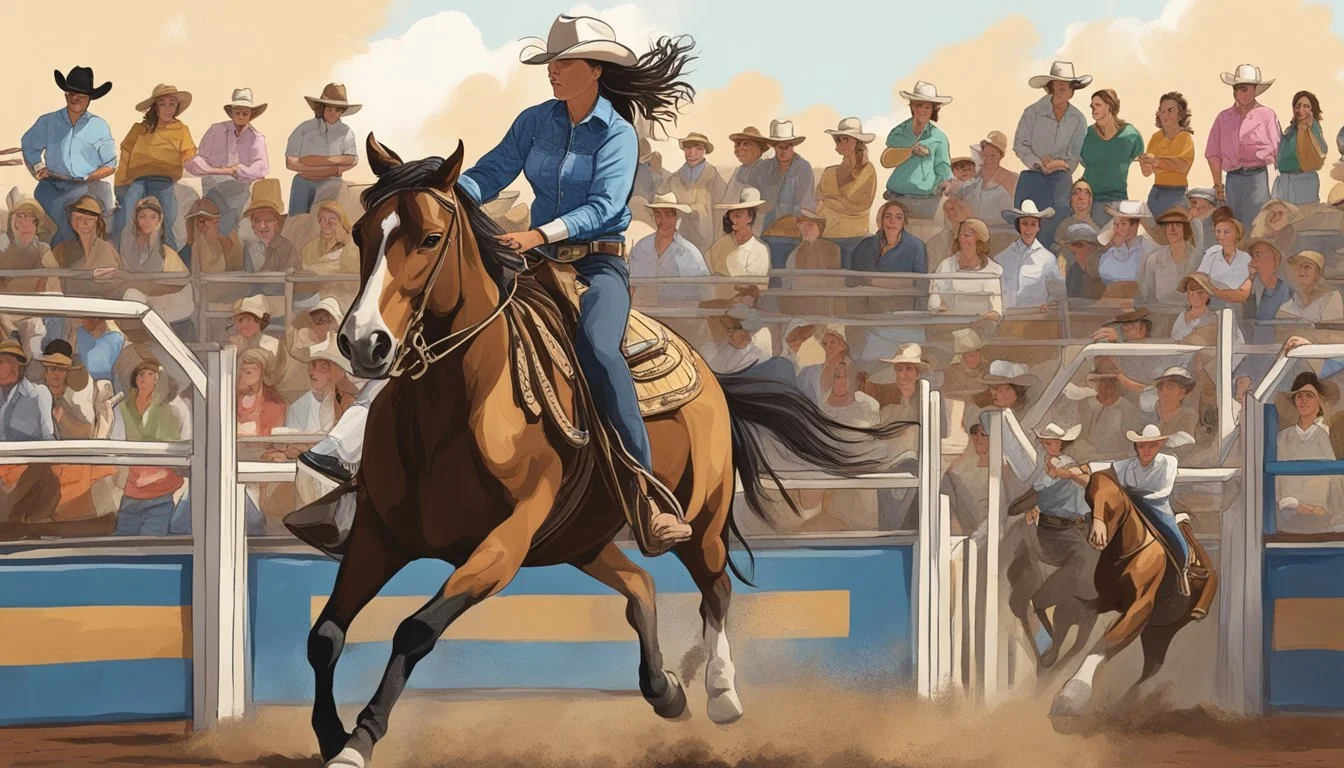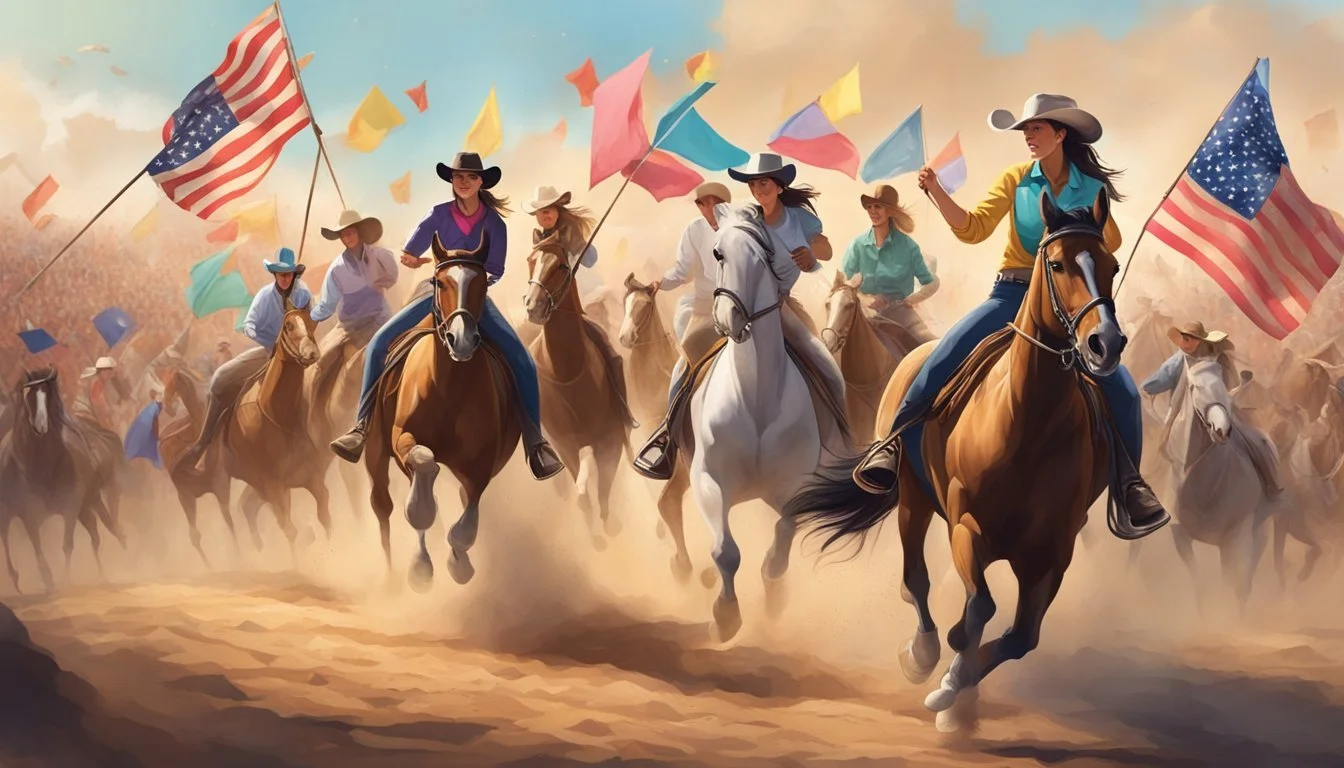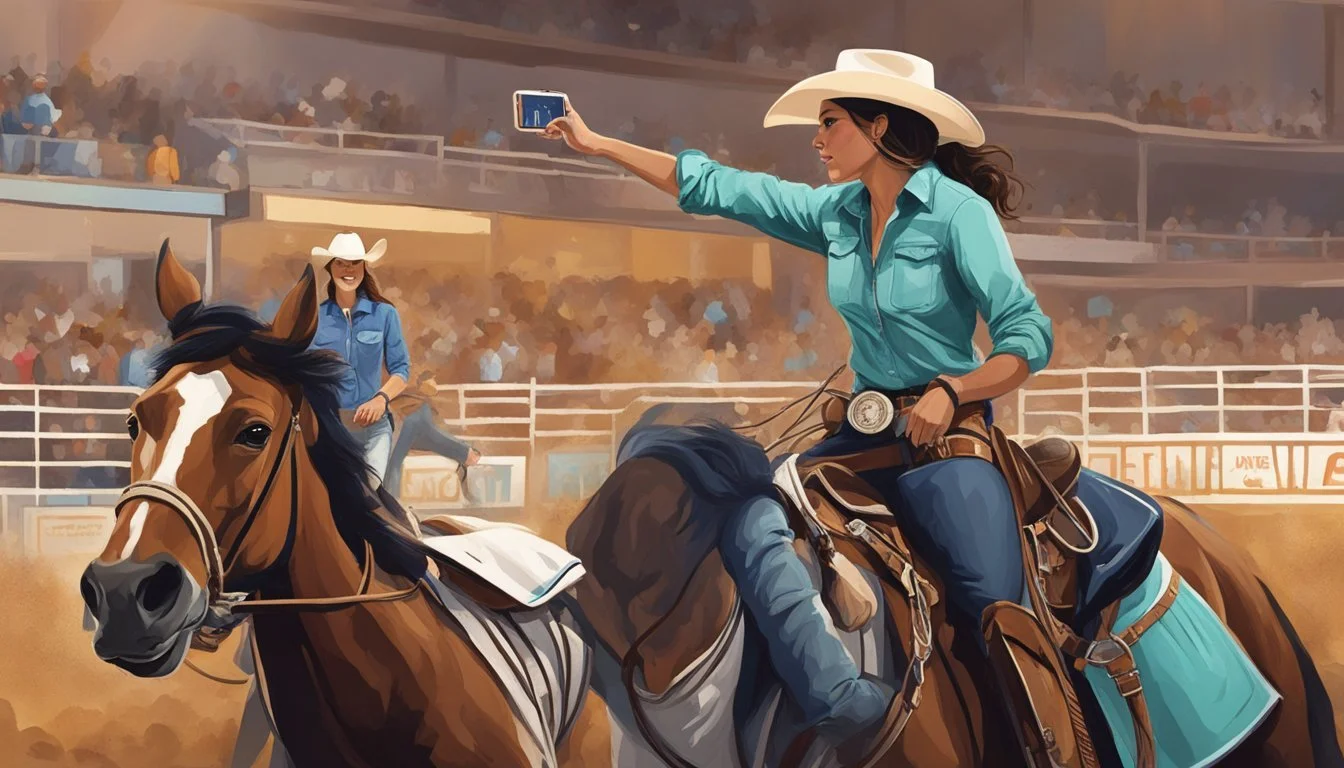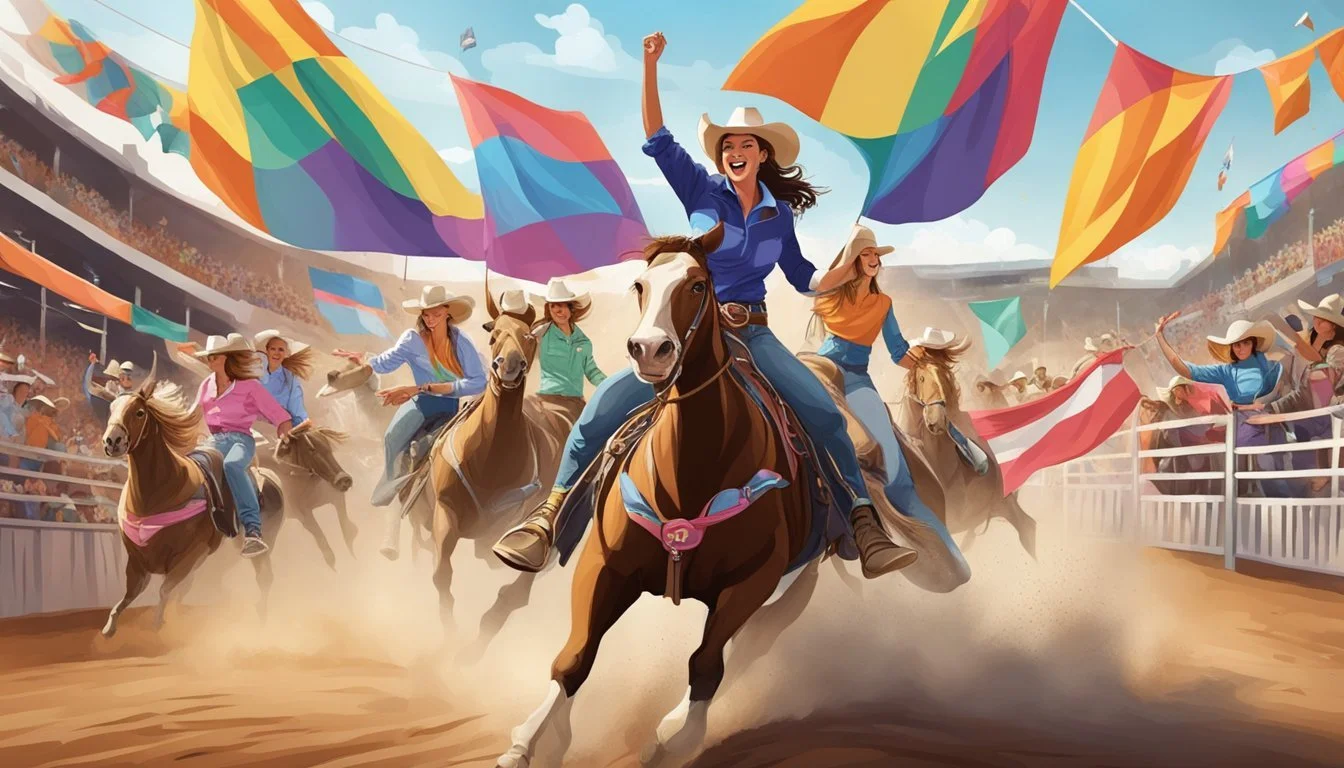The Rise of Women in Texas Rodeo
Pioneers of the Saddle Dominating the Scene
In Texas, where rodeo roots run deep and the cowboy culture is intertwined with state identity, women are carving out their place in the arena and reshaping the narrative. The traditionally male-dominated sport is experiencing a surge of female participation, as women not only compete fiercely but also win titles and earn recognition in events previously reserved for men. From breakaway roping where speed and precision merge, to the rough rides of bronc competitions, female cowgirls are not only participating but excelling and pushing the boundaries of the sport.
The determination of these women to succeed in rodeo is emblematic of broader societal changes. They are not content to stand on the sidelines; instead, they are taking center stage in arenas across Texas and beyond. Events like the Women's Rodeo World Championship in Fort Worth are a testament to this shift, providing a platform where women can showcase their skills and compete for significant titles. Their participation is redefining what it means to be a competitor in the world of professional rodeo.
With each rodeo, female competitors continue to break records, set new standards, and inspire the next generation of cowgirls. Their impact is not limited to individual achievements; they are altering the fabric of Texas rodeo culture, making it more inclusive and representative of all who share a passion for the sport. As these athletes take names and break barriers, they are crafting a new legacy that honors the spirit of competition and the diverse talents of competitors.
The Historical Context of Women in Rodeo
The transformation of women's roles from the sidelines to center stage in rodeo reflects a profound cultural shift in both the sport and American society. This section explores how women carved out their space in the rodeo world.
The Origins of Women in Rodeo
Women in rodeo began to gain visibility in the late 19th and early 20th centuries. Their participation marked a significant departure from conventional expectations of women's roles at the time. The Girls Rodeo Association, formed in 1948 by a group of West Texas women, marked a pivotal moment for women in the sport. This organization, which later became the Women's Professional Rodeo Association (WPRA), provided a platform for women to compete professionally. Women competed in a variety of events, including barrel racing, a sport where cowgirls race around a set pattern of barrels, showcasing both speed and precision.
Pioneers like Nancy Binford and Thena Mae Farr
Among the trailblazers of women's rodeo, Nancy Binford stood out as a powerful figure who not only competed but also shaped the sport's future through her organizational skills and advocacy. Thena Mae Farr, another iconic cowgirl, exemplified the skill and determination that became synonymous with women in the sport. These pioneers didn't just compete; they commanded respect and paved the way for future generations of female rodeo athletes.
Major Rodeo Events and Women's Participation
Women have increasingly become prominent participants in major rodeo events across Texas and beyond, showcasing skill and competitive spirit in a traditionally male-dominated sport.
San Angelo Rodeo Significance
San Angelo Rodeo has been a pivotal platform for female competitors, integrating women's events which emphasize the athletes' skill and contributions to the sport. San Angelo's commitment to inclusivity has transformed it into one of the significant rodeos where women not only participate but also excel in events such as barrel racing.
National Finals Rodeo
The National Finals Rodeo (NFR), held annually, stands as the premier championship rodeo event in the United States. Women have carved out their space in this prestigious event, particularly in barrel racing, where they compete for world titles and are recognized for their high levels of performance and athleticism.
Women's Rodeo World Championship
The Women's Rodeo World Championship (WRWC) is dedicated to women in the sport, offering a platform for the world's best female rodeo athletes. It features competitions in several disciplines, including barrel racing, breakaway roping, and team roping, setting a stage for women to showcase their talents and vie for substantial prizes and the honor of a world championship title.
Professional Organizations Advocating for Women
Professional organizations play a crucial role in promoting and supporting the involvement of women in the sport of rodeo. They create platforms for competition, provide opportunities for growth, and advocate for the interests of female athletes within this traditionally male-dominated arena.
Women's Professional Rodeo Association (WPRA)
The Women's Professional Rodeo Association (WPRA) is a distinguished body dedicated to promoting women in the sport of rodeo. It stands as the oldest women's sports organization in the United States and offers a wealth of opportunities and events specifically for women:
Events: Barrel racing, breakaway roping, and team roping.
Members: Over 3,000 dedicated female athletes competing at various levels.
Advocacy: Ensuring equal opportunities and prize money for women competitors.
By championing professional women rodeo athletes, the WPRA has been integral in elevating the status and recognition of women in the sport.
World Champions Rodeo Alliance (WCRA)
The World Champions Rodeo Alliance (WCRA) is a newer organization that works in conjunction with the WPRA to create additional opportunities for women in rodeo. The WCRA's contributions include:
Ranking System: A revolutionary points system to track athletes' performances across multiple rodeo events.
Events: An inclusive approach to their events, ensuring that both men's and women's competitions receive proper representation and visibility.
With the help of the WCRA, female rodeo athletes are able to compete on a larger stage and gain the recognition they deserve, contributing to the growth and popularity of the sport among women athletes.
Competitive Events Dominated by Women
In Texas rodeo, women have come to excel in specific events, showcasing skill and competitiveness that stand out in the rodeo arena. Barrel racing and breakaway roping have become prominent platforms where cowgirls demonstrate their athleticism and command respect for their achievements.
Barrel Racing: An Overview
Barrel racing is a high-speed, precision event in which female athletes race against the clock to complete a cloverleaf pattern around preset barrels. It is a standout event in women's rodeo, both in terms of speed and the level of skill required. Here are key facts about barrel racing:
Objective: Athletes aim to run the pattern in the shortest possible time without knocking over any barrels.
Horsepower: Success in barrel racing heavily relies on the partnership between the horse and the rider, with the horse's agility and speed playing a critical role.
Scoring: Time penalties are incurred for each barrel knocked over, typically adding five seconds per barrel to the rider's total time.
In recent events, like the 2023 Women's Rodeo World Championship, barrel racing has witnessed record-breaking runs, with athletes pushing the boundaries of speed and technique.
The Popularity of Breakaway Roping
Breakaway roping is a fast-paced rodeo event rapidly growing in popularity among female rodeo athletes. Here's a concise breakdown of the event:
Objective: Cowgirls lasso a calf as quickly as possible, with the rope 'breaking away' once it is caught, signaling the end of the run.
Skillset: Breakaway roping demands precision, timing, and a solid understanding of roping and horsemanship.
Growth: This event has seen a surge in participation, as it provides a platform for women's talent in the traditionally male-dominated sport of rodeo.
Athletes competing in the 2023 Women's Rodeo World Championship exemplified the high level of competition in breakaway roping, with contenders delivering swift and precise performances that captivated the audience.
Economic Aspects of Women’s Rodeo
In the world of women's rodeo, financial rewards and strategic partnerships have been instrumental in shaping its landscape. The economics of women's rodeo encompass prize money and annual purses, the influence of sponsorships on the rodeo economy, and the pivotal role of rodeo committees in steering the financial success of events.
Prize Money and the Annual Purse
Prize money is a direct indicator of the popularity and recognition of women's rodeo. Historically, prize pools have been lower for women than men but are increasing as women's participation and viewership grow. In recent years, the annual purse—the total prize money distributed over the season—has seen a consistent rise. Notable rodeos have set precedents with large purses significantly rewarding female competitors' skill and dedication.
Sponsorships and the Rodeo Economy
Sponsorships are the lifeline of the rodeo economy, providing essential funding for events and athletes. Women's rodeo has attracted a broad range of sponsors from western wear brands to agricultural and lifestyle companies. These partnerships not only finance prizes but also cover operational costs, ensuring the sustainability of rodeos. The visibility these sponsors receive is amplified by the purchasing power of women, as evidenced by their significant representation in rodeo attendance and ticket purchases.
Rodeo Committees' Role
Rodeo committees are gatekeepers responsible for organizing events, securing sponsorships, and allocating prize money. Their decisions impact the economic vitality of women's rodeo. These committees play a crucial role in marketing, negotiating sponsorship deals, and implementing strategies that prop up the financial stakes of the sport. As committees recognize the value women bring to rodeo, they are increasingly investing in women's events, adding to the growth and financial rewards of the sport.
Notable Women in Rodeo and Their Achievements
The rise of women in Texas rodeo is marked by inspiring stories of champions who have excelled in various rodeo disciplines. From trailblazers who paved the way to contemporary stars who continue to redefine the sport, their accomplishments reflect their dedication and skill.
Profiles of Champions
The rich heritage of women's rodeo boasts names like Isora DeRacy Young, an early champion and inductee into the National Cowgirl Museum and Hall of Fame. These women not only excelled in traditional events like bronc riding and team roping but also in setting standards for prize money and recognition. They played an integral role in establishing the Women's Professional Rodeo Association (WPRA), the oldest women's professional sports organization in the U.S., ensuring that women had a voice and platform in the sport. Through the WPRA, event champions emerged in disciplines such as team roping and breakaway roping, receiving earnings that elevated the status of the cowgirl to that of their male counterparts in the Rodeo Cowboys Association (PRCA).
Casey Tibbs and His Impact on Women's Rodeo
Casey Tibbs, a famed rodeo cowboy, significantly influenced women's rodeo by supporting and advocating for cowgirl events. He recognized the talent and potential of female athletes and helped to create more opportunities for them to compete. His impact is seen in the rise of women's events and the integration of women into high-profile rodeo organizations and competitions, including those governed by the World Champions Rodeo Alliance (WCRA).
Contemporary Stars: Jackie Crawford and Martha Angelone
In today's arena, Jackie Crawford and Martha Angelone stand out as leading figures. Crawford, an all-around cowgirl, has secured her place in rodeo history with multiple world championships and significant prize money, challenging the norms and expectations within the sport. Meanwhile, Martha Angelone has become a key face in the breakaway roping event championship, demonstrating the evolution of women's rodeo and its continued relevance in the current era. Both athletes reflect the ongoing spirit of the WPRA and the groundbreaking efforts of those who came before them, pushing boundaries and inspiring a new generation of rodeo cowgirls.
Rodeo's Evolution and the Role of Technology
As the sport of rodeo evolves, technology plays a crucial role in expanding its reach and modernizing its practices, particularly in enhancing media exposure and improving the accessibility of competitions.
The Cowboy Channel and Media Exposure
The Cowboy Channel represents a significant milestone in the evolution of rodeo, serving as the primary source of media exposure for the sport. This dedicated television network broadcasts rodeo events, providing unprecedented coverage and bringing the thrill of rodeo into homes across the nation. Media exposure through the Cowboy Channel has introduced rodeo to a broader audience, offering high-definition broadcasts and on-demand services that showcase the talents of both male and female competitors, ensuring the sport's rich heritage and present-day exploits are accessible to all.
Virtual Rodeo Qualifiers and Accessibility
With the introduction of virtual rodeo qualifiers, rodeo has embraced digital innovation to facilitate broader participation in the sport. Competitors can record their performances remotely and submit them for qualification in larger rodeo events. This method not only bypasses geographical limitations but also opens up the sport to a wider pool of talent, including women who are looking to make their mark. Virtual qualifiers serve as a stepping stone, allowing more athletes the chance to compete and prove themselves in professional arenas without the constraint of traveling to multiple distant locations.
Current Challenges and Opportunities in Women's Rodeo
Women's participation in rodeos has surged, yet challenges persist alongside unique opportunities, signaling a transformative era for these athletes in a traditionally male-dominated sport.
Striving for Gender Diversity
Gender diversity in rodeos remains a crucial issue. Women account for a significant majority of rodeo attendees, and their involvement is growing at both amateur and professional levels. Despite their strong presence as spectators, diversifying the arena itself has been slower. However, organizations are now more keen on advancing women to not only compete but to lead, as seen with high-profile executives like Linsay Rosser Sumpter at the helm of the Women’s Rodeo World Championship.
Categorization and Recognition of Women Athletes
Women athletes in rodeo often face challenges in gaining equal recognition. Historically, coverage and sponsorships have skewed towards male events. Yet, the tides are shifting. Women's rodeo categories in major competitions like the Fort Worth Stock Show and Rodeo are receiving more attention, and prize payouts have begun to rise, creating stronger incentives for women to compete at the highest levels, including the challenger class and prorodeo events.
The Future for Female Bull Riders
Female bull riders, or cowgirls, stand at an interesting juncture. Often relegated to auxiliary competitions, they now encounter a growing number of platforms dedicated to their events. Female bull riding is not yet as established as other women's events within the rodeo, but there is momentum building. Initiatives and dedicated championships are setting the stage for an expansion in visibility and competitive opportunities for these bold athletes.








